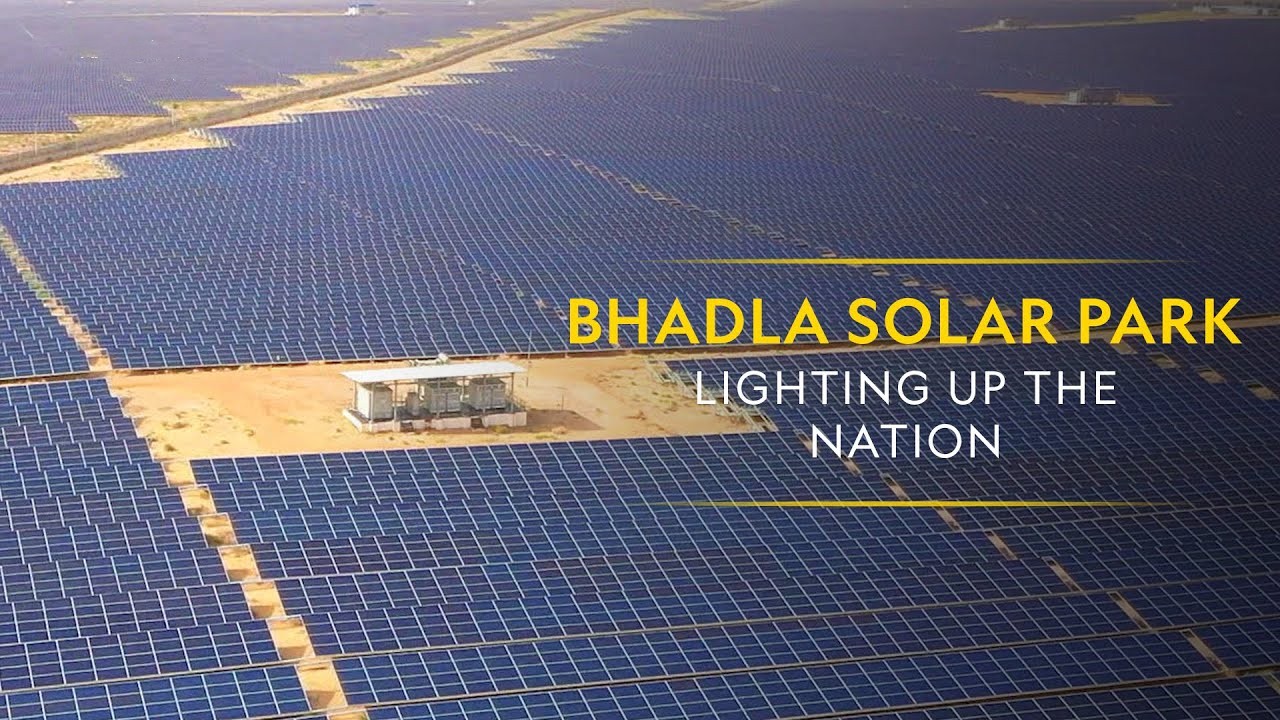 World’s Largest Solar Plant Bhadla Solar Park
World’s Largest Solar Plant Bhadla Solar Park
The Bhadla Solar Park is a Solar power plant located in the Thar desert of Rajasthan, India. It covers an area of 56 square kilometers and has a total installed capacity of 2,245 (MW), making it the largest solar park in the world. It is a solar photovoltaic power plant. The project was started in 2015. Around $1.4 billion have been invested into this project. The park contributes to India’s renewable energy goals and helps reduce greenhouse gas emission by an estimated 4 million tons per year.

Development of Bhadla Solar Power Plant
The Bhadla Solar Park was initiated by the Rajasthan Renewable energy corporation (RRECL), a joint venture between the Government of Rajasthan and the Ministry of New and Renewable energy (MNRE). The RRECL identified Bhadla, a remote area in the Phalodi tehsil of Jodhpur district as a suitable site for solar power generation due to its high solar irradiance, low population density , and availability of government-owned land. The park was developed in four phases since 2015, with $775 million in funding from the climate Investment Fund and $1.4 billion in funding from other sources. The first phase of the solar park has seven solar power plants with a combined capacity of 75MW, while phase two has ten solar power plants with a combined capacity of 680MW. Phases three and four will have ten solar power plants each, with combined capacities of 1,000MW and 500MW respectively.
National Thermal Power Corporation (NTPC) and Solar Energy Corporation of India (SECI) are responsible for assigning developers for the solar power plants. The two organizations have signed 25-year power purchase agreement with developers. The solar power plants under the third phase are being developed by Hero Future Energies (300MW), Softbank Group (200MW), ACME Solar (200MW), and SB Energy (300MW). Azure Power (200MW), ReNew Solar Power (50MW), Phelan Energy Group (50MW), Avaada Power (100MW), and SB Energy (100MW) are undertaking development of the solar power plants under the fourth phase.
A Site for Renewable Energy Production
The average temperature in Bhadla is around 46 to 48 degrees, with the climate being sandy, dry, and arid with frequent sandstorms. This kind of climate is generally uninhabitable and makes it ideal for tapping solar energy and generating massive amounts of energy. With a burgeoning population and growing demand for fuels, projects like Bhadla Solar Park are helping our country reduce its dependence on fossil fuels. It has enabled us to explore renewable energy as an alternative source and is also driving economic growth and job creation around the surrounding areas.
The Bhadla Solar Power Plant project is greatly helping India minimise its dependence on fossil fuels. It is one of the major factors that encourage economic growth in the region. The impact is not just limited to the region but also affects the country’s economy as a whole. The development of the Bhadla Solar Power Plant in Jodhpur has led to improved air quality in the city due to the reduced burning of fossil fuels for energy. The Bhadla Solar Park relies on pure solar energy to create power. Thus, it is a source of consistent green power supply to the national grid. The Bhadla Solar Plant produces up to 732,874 MWh per year.
Power Evacuation System
The power evacuation functionality has been developed by the PGCIL (Powergrid Corporation of India) and TRANSCO (State-owned Transmission Company), which is to be delivered to the state board of the government.
The PGCIL is to establish 765/400/220kV grid substations along with the pooling stations at Bhadla Solar Park. A transmission system with 400kV and 765kV double circuit lines, along with four 220kV and two 400kV line bays, will also be laid down for the solar plant interconnections. Also, the TRANSCO will also generate 400/220/132kV grid substations with the purpose of power evacuation.
Conclusion
Solar power projects like Bhadla Solar Power Plant are enabling India to lessen its reliance on non-renewable imported fossil fuels. The plant is operational 24 hours a day. With its low-cost loans on solar panels, this social infrastructure project helps to lessen its dependence on imported fossil fuels. Encouraging such technology, the government of India has introduced a pollution-free and much healthier replacement of power production against the kerosene indoor lightning.
Read More: Approved Solar PV Module Manufacturers in India: What You Need to Know


